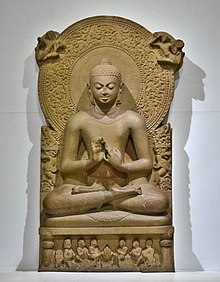
Back Buddha-Statue German Budarupa Spanish Buda (estatua) Basque बुद्धरूप Hindi Buddharúpa Hungarian Buddharupa ID 仏像 Japanese ព្រះពុទ្ធរូប Cambodian 불상 Korean Buddharupa Dutch
This article needs additional citations for verification. (June 2018) |

| Part of a series on |
| Buddhism |
|---|
 |
Much Buddhist art uses depictions of the historical Buddha, Gautama Buddha, which are known as Buddharūpa (lit. 'Form of the Awakened One') in Sanskrit and Pali. These may be statues or other images such as paintings. The main figure in an image may be someone else who has obtained Buddhahood, or a boddhisattva, especially in the various traditions of Mahayana Buddhism. Other Buddhas and bodhisattvas in art have become increasingly common over the centuries, perhaps now outnumbering images of the historical Buddha.
In its first centuries Buddhism was largely or entirely aniconic, not showing the person of Buddha except by symbols and relics. This changed, and figures of the Buddha became very common in the art of Gandhara and Gupta art. As forms of esoteric Buddhism developed, other figures from the expanding array of Buddhist sacred persons became more prominent. In Theravada Buddhism this was much less the case, and figures of the historical Buddha remain the most common main images in temples and shrines to the present.
Early images were most often of Buddha standing, but seated meditating postures, essentially the lotus position of yoga, came to predominate. Often these represent a specific moment in the Buddha's life, which is identified by the Buddha's hand gesture (mudra), or attributes shown. There are also statues of the Reclining Buddha, lying down, usually showing the moment of his death.
Sets of narrative scenes from the life of the Buddha tend to concentrate on standard groupings such as the Eight Great Events or other sets, but may be much larger. Originally common in reliefs, and probably paintings of which few have survived, they have more recently mostly been in painted form. Narrative scenes may show the Buddha in various poses, though they tend to show the Buddha in the same standing, seated or lying positions, with other figures or a mudra indicating what moment is being depicted.
-
Giant Amida Buddha of Kamakura, Japan, 1252. This represents Amitābha, not the historical Buddha, though the depiction is very similar.
-
Golden Buddha of Wat Traimit, Bangkok, Thailand
-
Large Gautama Buddha statue in Buddha Park of Ravangla, Sikkim, India
© MMXXIII Rich X Search. We shall prevail. All rights reserved. Rich X Search


